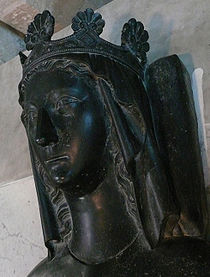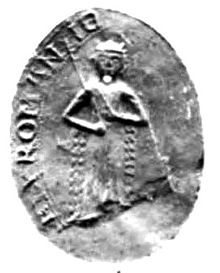- Marie of Brienne
-
Marie of Brienne 
Latin Empress consort Tenure 1234–1261 Spouse Baldwin II of Constantinople Issue Philip of Courtenay
Artesia XIV.House House of Brienne
Capetian House of CourtenayFather John of Brienne, Latin Emperor Mother Berengaria of León Born April 1225
CapuaDied after 5 May 1275
in ItalyBurial Assisi Religion Roman Catholicism Marie of Brienne (c. 1225–1275) was the Empress consort of Baldwin II of Courtenay, Latin Emperor of Constantinople.
Contents
Family
She was a daughter of John of Brienne and his third wife Berenguela of Leon. Marie was a younger, paternal half-sister of Yolande of Jerusalem. She was also a sister of Alphonso of Brienne.
Her matermal grandparents were Alfonso IX of León and his second wife Berenguela of Castile.
Marriage
On 19 April 1229, Marie was betrothed to Baldwin II, junior co-ruler of her father in the throne of the Latin Empire. The marriage was intended to establish a dynastic alliance between the two co-rulers. Marie was at most four-years-old at the time of her betrothal, her parents having married in 1224.
Their marriage took place in 1234. The bride was about nine-years-old, the groom seventeen. By her marriage Marie became the junior co-empress of the Latin Empire. The senior one being her mother. Their marriage was recorded in the chronicle of Alberic of Trois-Fontaines.
Empress
In 1236, Constantinople was besieged by the combined forces of Ivan Asen II of Bulgaria and John III Doukas Vatatzes of the Empire of Nicaea. The city was only defended by its small garrison of knights, the fleet of the Republic of Venice and a minor force sent by Geoffrey II of Villehardouin, Prince of Achaea to reinforce the defense. The city was only spared conquest because of a quarrel between the two allies over who would receive command of the city in the event of a success. John V.A. Fine has suggested that Ivan Asen realised the greater threat posed to the Second Bulgarian Empire by the expansion of Nicaea rather than the weakened Latin Empire.[1]
In any case, John of Brienne had taken command of the defense of Constantinople. Baldwin II undertook another mission, heading to Western Europe in attempt of raising the funds and recruiting the armed forces needed to secure the survival of their Empire.[2] John died on 27 March 1237,[3] Berenguela following him on 12 April.[4] The twelve-year-old Marie was left in nominal command of the city, as the sole representative of the imperial family present in it. Baldwin would not return until July, 1239.[5] [[Narjot de Toucy (died 1241)
Baldwin returned at the head of a Crusading force from Western Europe, variously estimated to include as few as thirty thousand men or as many as sixty thousand. This force was joined by a contingent of Cumans, combining to besiege Tzurulum, a Nicaean strongold in Thrace. The city fell in 1240 but this seems to have been the only success of this force. They are not mentioned afterwards. John V.A. Fine presumes that most of them returned to their homes in Western Europe, only a few of them joining the existing garrison of Constantinople. For the moment, the Latin Empire had ensured its continued survival.[5] Marie was approximately fifteen-year-old at the time her husband returned to his capital.
On 15 April 1240 (Easter), Baldwin II was crowned emperor in Hagia Sophia. Their only known son, Philip of Courtenay, was born in 1243. However this period of relative peace for the couple was not to last. Baldwin left for the Kingdom in France by the end of 1243, intending to seek support from Louis IX of France. In his absence Marie became regent of the Empire, with Philip of Toucy as her initial co-regent. Philip was a son of Narjot of Toucy and his first wife. His mother was a daughter of Theodore Branas and Agnes of France.[6] Baldwin was absent for several years, first staying in France and then joining Louis IX in the Seventh Crusade. He reportedly only returned in 1257 or 1258, possibly following the death of Theodore II Laskaris.
Fall of Constantinople
The imperial couple would not hold their capital for long. In July, 1261, Alexios Strategopoulos, a general of Nicaea, was sent with a small advance force of 800 soldiers, most of them Cumans,[7] to keep a watch on the Bulgarians and spy out the defences of the Latins.[8] When the Byzantine force reached the village of Selymbria, they learned from independent local farmers (thelematarioi) that the entire Latin garrison, and the Venetian fleet, were absent conducting a raid against the Nicaean island of Daphnousia.[9] Although initially hesitant, due to both the small size of his force, which might be fatal if the Latin army returned, and because he would exceed his orders, Strategopoulos eventually decided not to lose such a golden opportunity to retake the city.[8]
On the night of July 25, 1261, Alexios and his men approached the city walls and hid at a monastery near the Pege Gate.[7] Alexios sent a detachment of his men, who, led by some of the thelematarioi, made their way to the city through a secret passage. They attacked the walls from the inside, surprised the guards and opened the gate, allowing the Byzantine force entry into the city.[8] The Latins were taken completely by surprise, and after some fighting, the Byzantine force gained control of the land walls. Fearing the revenge the Byzantines would exact upon them, the Latin inhabitants, from Emperor Baldwin II downwards, hurriedly rushed to the harbour, hoping to escape by ship. Thanks to the timely arrival of the returning Venetian fleet, they were evacuated, but the city was lost for good.[8] Marie presumably managed to flee with her husband.
Exile
A Venetian ship took Baldwin and Marie to Euboea, from there proceeding to Athens, Apulia and then back to France. In the following years they survived by selling their de facto and de jure rights to various secondary titles and lands.
On 26 March 1263, their rights to Namur were bought by Guy of Dampierre.[10] Namur was at the time actually held by Henry V of Luxembourg but Guy would successfully conquer it by 1268. In January, 1266, their rights to the Kingdom of Thessalonica were bought by Hugh IV, Duke of Burgundy for 13,000 livres tournois.[11] At the time the city was under the control of Michael VIII Palaiologos, the Nicaean emperor who had moved his capital to Constantinople, while the title was also claimed by William VII, Marquess of Montferrat.
On 27 May 1267, the Treaty of Viterbo, transferred much of the rights to the Latin Empire fiefs from Baldwin II to Charles I of Sicily.[12] Charles was to be confirmed in possession of Corfu and some cities in Albania. He was also given suzerainty over the Principality of Achaea and sovereignty of the Aegean Islands, excepting those held by Venice and Lesbos, Chios, Samos, and Amorgos.
Baldwin and Marie spend the rest of their lives in the court of Charles. In October, 1273, Baldwin died in Naples. Marie survived him by about two years. She was buried in Assisi.
Ancestry
Ancestors of Marie of Brienne 16. Erard I of Brienne 8. Gautier II of Brienne 17. Alix of Roucy-Ramerupt 4. Erard II of Brienne 18. John I, Count of Soissons 9. Adele of Soissons 19. Aveline de Pierrefonds 2. John of Brienne 20. Richard II of Montfaucon 10. Amadeus II of Montfaucon 21. Sophie of Montbéliard 5. Agnes of Montfaucon 11. Beatrice of Grandson-Joinville 1. Marie of Brienne 24. Alfonso VII of León and Castile 12. Ferdinand II of León 25. Berenguela of Barcelona 6. Alfonso IX of León 26. Afonso I of Portugal 13. Urraca of Portugal 27. Maud of Savoy 3. Berengaria of León 28. Blanche of Navarre 14. Alfonso VIII of Castile 29. Sancho III of Castile 7. Berenguela of Castile 30. Henry II of England 15. Eleanor of England 31. Eleanor of Aquitaine External links
- The page of the "Late Medieval Balkans" mentioning the siege
- Her profile, along with her husband, in "Medieval Lands" by Charles Cawley
References
- ^ John V.A. Fine, Jr., The Late Medieval Balkans (1987), page 130
- ^ John V.A. Fine, Jr., The Late Medieval Balkans (1987), pages 130
- ^ Alberic of Trois-Fontaines, Chronica Albrici Monachi Trium Fontium, MGH SS XXIII
- ^ Obituaires de Sens Tome I.2 of the Abbey de Maubuisson, p. 655
- ^ a b John V.A. Fine, Jr., The Late Medieval Balkans (1987), page 132
- ^ Charles Cawley "Narjot de Toucy"
- ^ a b Bartusis, Mark C. The Late Byzantine Army: Arms and Society, 1204–1453 (1997), p. 27.
- ^ a b c d Nicol, Donald M. The Last Centuries of Byzantium 1261–1453 (1993), p. 34.
- ^ Bartusis, Mark C. The Late Byzantine Army: Arms and Society, 1204–1453 (1997) (1997), p. 40.
- ^ Kerrebrouck, Patrick van, "Les Capétiens" (2000), p. 462.
- ^ Mihail-Dimitri Sturdza, Dictionnaire historique et Généalogique des grandes familles de Grèce, d'Albanie et de Constantinople (1983), p. 489.
- ^ John V.A. Fine, Jr., The Late Medieval Balkans (1987), page 170
Royal titles Preceded by
Berenguela of LeonLatin Empress consort of Constantinople
1234–1261
with Berenguela of Leon (1229–1237)Succeeded by
NoneTitles in pretence Loss of title
Fall of Constantinople— TITULAR —
Latin Empress consort of Constantinople
1261–1273
Reason for succession failure:
Conquest by Empire of NicaeaSucceeded by
Beatrice of SicilyCategories:- 1225 births
- 1275 deaths
- Capetian House of Courtenay
- Latin Empresses of Constantinople
- House of Brienne
Wikimedia Foundation. 2010.

